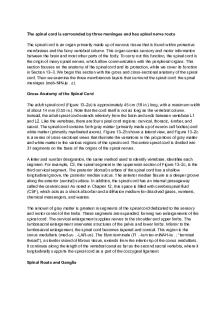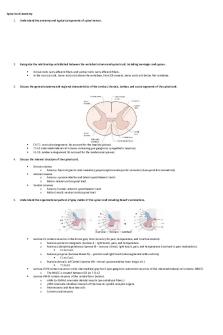The spinal cord is surrounded by three meninges and has spinal nerve roots PDF

| Title | The spinal cord is surrounded by three meninges and has spinal nerve roots |
|---|---|
| Course | Human Anatomy and Physiology with Lab II |
| Institution | The University of Texas at Dallas |
| Pages | 2 |
| File Size | 55.8 KB |
| File Type | |
| Total Downloads | 87 |
| Total Views | 191 |
Summary
The spinal cord is surrounded by three meninges and has spinal nerve roots...
Description
The spinal cord is surrounded by three meninges and has spinal nerve roots The spinal cord is an organ primarily made up of nervous tissue that is found within protective membranes and the bony vertebral column. This organ carries sensory and motor information between the brain and most other parts of the body. To carry out this function, the spinal cord is the origin of many spinal nerves, which allow communication with the peripheral organs. This section focuses on the anatomy of the spinal cord and its protection, while we cover its function in Section 13–3. We begin this section with the gross and cross-sectional anatomy of the spinal cord. Then we examine the three membranous layers that surround the spinal cord: the spinal meninges (meh-NIN-je . z). Gross Anatomy of the Spinal Cord The adult spinal cord (Figure 13–2a) is approximately 45 cm (18 in.) long, with a maximum width of about 14 mm (0.55 in.). Note that the cord itself is not as long as the vertebral column. Instead, the adult spinal cord extends inferiorly from the brain and ends between vertebrae L1 and L2. Like the vertebrae, there are four spinal cord regions: cervical, thoracic, lumbar, and sacral. The spinal cord contains both gray matter (primarily made up of neuron cell bodies) and white matter (primarily myelinated axons). Figure 13–2b shows a lateral view, and Figure 13–2c is a series of cross-sectional views that illustrate the variations in the proportions of gray matter and white matter in the various regions of the spinal cord. The entire spinal cord is divided into 31 segments on the basis of the origins of the spinal nerves. A letter and number designation, the same method used to identify vertebrae, identifies each segment. For example, C3, the spinal segment in the uppermost section of Figure 13–2c, is the third cervical segment. The posterior (dorsal) surface of the spinal cord has a shallow longitudinal groove, the posterior median sulcus. The anterior median fissure is a deeper groove along the anterior (ventral) surface. In addition, the spinal cord has an internal passageway called the central canal. As noted in Chapter 12, this space is filled with cerebrospinal fluid (CSF), which acts as a shock absorber and a diffusion medium for dissolved gases, nutrients, chemical messengers, and wastes. The amount of gray matter is greatest in segments of the spinal cord dedicated to the sensory and motor control of the limbs. These segments are expanded, forming two enlargements of the spinal cord. The cervical enlargement supplies nerves to the shoulder and upper limbs. The lumbosacral enlargement innervates structures of the pelvis and lower limbs. Inferior to the lumbosacral enlargement, the spinal cord becomes tapered and conical. This region is the conus medullaris (med-yu . -LAR-us). The filum terminale (FI . -lum ter-miNAH-la . ; “terminal thread”), a slender strand of fibrous tissue, extends from the inferior tip of the conus medullaris. It continues along the length of the vertebral canal as far as the second sacral vertebra, where it longitudinally supports the spinal cord as a part of the coccygeal ligament. Spinal Roots and Ganglia
Every spinal segment is associated with a pair of spinal ganglia (dorsal root ganglia) located near the spinal cord (see Figure 13–2c). These ganglia contain the cell bodies of sensory neurons. The axons of the neurons form the posterior roots or dorsal roots, which bring sensory information into the spinal cord. A pair of anterior roots, or ventral roots contains the axons of motor neurons that extend into the periphery to control somatic and visceral effectors. The roots of all spinal nerves divide in fanlike fashion, forming rootlets, before entering or leaving the spinal cord. A spinal posterior root may divide into 8–12 rootlets (Figure 13–3a). On both sides, the posterior and anterior roots of each segment pass between the vertebral canal and the periphery at the intervertebral foramen between successive vertebrae. The spinal ganglion lies between the pedicles of the adjacent vertebrae.
The spinal cord continues to enlarge and elongate until approximately 4 years of age. Up to that time, enlargement of the spinal cord keeps pace with the growth of the vertebral column. Throughout this time, the posterior and anterior roots are very short, and they enter the intervertebral foramina immediately adjacent to their spinal segment. After age 4, the vertebral column continues to elongate, but the spinal cord does not....
Similar Free PDFs

ANS and Spinal Cord Labeling
- 3 Pages

Spinal cord, medulla spinalis
- 5 Pages

Spinal Cord and Lower Brain
- 5 Pages

Spinal Cord Injury
- 1 Pages

Ch17 Spinal Cord Nerves
- 4 Pages
Popular Institutions
- Tinajero National High School - Annex
- Politeknik Caltex Riau
- Yokohama City University
- SGT University
- University of Al-Qadisiyah
- Divine Word College of Vigan
- Techniek College Rotterdam
- Universidade de Santiago
- Universiti Teknologi MARA Cawangan Johor Kampus Pasir Gudang
- Poltekkes Kemenkes Yogyakarta
- Baguio City National High School
- Colegio san marcos
- preparatoria uno
- Centro de Bachillerato Tecnológico Industrial y de Servicios No. 107
- Dalian Maritime University
- Quang Trung Secondary School
- Colegio Tecnológico en Informática
- Corporación Regional de Educación Superior
- Grupo CEDVA
- Dar Al Uloom University
- Centro de Estudios Preuniversitarios de la Universidad Nacional de Ingeniería
- 上智大学
- Aakash International School, Nuna Majara
- San Felipe Neri Catholic School
- Kang Chiao International School - New Taipei City
- Misamis Occidental National High School
- Institución Educativa Escuela Normal Juan Ladrilleros
- Kolehiyo ng Pantukan
- Batanes State College
- Instituto Continental
- Sekolah Menengah Kejuruan Kesehatan Kaltara (Tarakan)
- Colegio de La Inmaculada Concepcion - Cebu










